- Introduction
- Exercise 2.1 - part 1
- Exercise Problems-2.1 - Part 2
- Exercise 2.2
- Exercise 2.3- part 1
- Exercise 2.3 - part 2
- Algebraic Identities
- Example Problems-2.4
- Exercise 2.4 - part 1
- Exercise Problems 2.4 - part 2
- Exercise Problems 2.4 - part 3
- Exercise 2.5 - Part 1
- Exercise Problems 2.5 - part 2
- Introduction
- Surface Area and Volume of a Cube
- Surface Area and volume of a Cuboid
- Surface Area and Volume of a Right Circular Cylinder
- Surface Area and Volume of a Hollow Right Circular Cylinder
- Surface Area and Volume of a Right Circular Cone
- Surface Area and Volume of a Sphere
- Surface Area and Volume of a Hemisphere
- Exercise 10.1
Exercise 4.4 part 1
Exercise 4.4
1.In the given triangles, find out x, y and z

Sol. In fig(i)
x^{\circ}=50^{\circ}+60^{\circ}
(\therefore exterior angle is equal to sum of the opposite interior angles)
\therefore x=110^{\circ}
In fig (ii)
z^{\circ}=60^{\circ}+70^{\circ}
(\therefore exterior angle is equal to sum of the opposite interior angles)
\therefore x=130^{\circ}
In fig(iii)
y^{\circ}=35^{\circ}+45^{\circ}=80^{\circ}
(\therefore exterior angle is equal to sum of the opposite interior angles)
2.In the given figure AS || BT; ∠4 = ∠5\overline{SB} bisects ∠AST. Find the measure of ∠1.
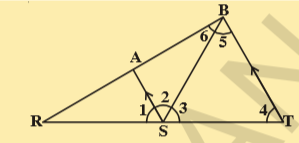
Sol. Given AS || BT
\angle 4=\angle 5 and \overline{SB} bisects \angle AST.
\therefore BY PROBLEM
\angle 2=\angle 3.........(i)
for the lines AS\parallel BT
\angle 2=\angle 5(\because alternate interior angles)
\therefore In \Delta BST
\angle 3=\angle 5=\angle 4
Hence \Delta BST is equilateral triangle and each of its angle is equal to 60^{\circ}
\therefore \angle 3=\angle 2=60^{\circ}
Now \angle 1+\angle 2+\angle 3=180^{\circ}
\therefore \angle 1+60^{\circ}+60^{\circ}=180^{\circ}
\because angle at a point on a line
\therefore \angle 1= 180^{\circ}-120^{\circ}=60^{\circ}
3.In the given figure AB || CD; BC || DE then find the values of x and y.
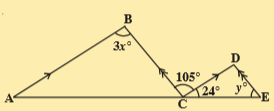
Sol.Given that AB || CD; BC || DE .
\therefore 3x=105^{\circ} (\because alternate interior angles for AB\parallel CD)
X= \frac{105^{\circ}}{3} = 35^{\circ}
Also BC\parallel DE
\therefore \angle D=105^{\circ}
\because alternate interior angles
Now in \Delta CDE
24^{\circ}+105^{\circ}+Y=108^{\circ}
\because angle sum property
\therefore y=180^{\circ}-129^{\circ}=51^{\circ}
4.In the adjacent figure BE ⊥ DA and CD⊥DA then prove that m∠1 ≅ m∠3.
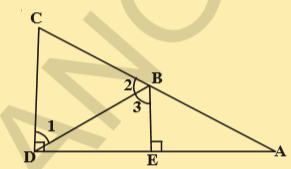
Sol.Given that CD⊥DA and BE ⊥ DA.
\Rightarrow Two lines CD and BE are perpendicular to the same line DA.
\Rightarrow CD\parallel BE(or)
\angle D=\angle E\Rightarrow CD\parallel BE
\because corresponding angles for CD and BE and DA are transversal
Now m\angle 1=m\angle 3
\because altenate interior angles for the lines CD\parallel BE ; DB are transversal
Hence proved.
5.Find the values of x, y for which the lines AD and BC become parallel.
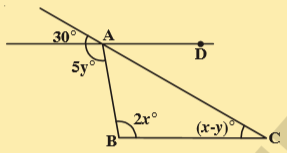
Sol.For the loines AD and BC to be parallel x-y- 30^{\circ}(corresponding angles) ...........(1)
2x=8y ........(2)
(\because alternate interior angles)
solving(1)&(2)
(1)x(2)=2x-2y=60
2 =2x-8y=0
6y=60
y=\frac{60}{6} =10^{\circ}
substituting y=10^{\circ} in eq.(1)
x-10^{\circ}=30^{\circ}
\Rightarrow x=40^{\circ}
\therefore x=40^{\circ} and y=10^{\circ}
6. Find the values of x and y in the figure.
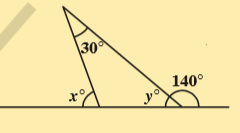
Sol.From the figure y+ 140^{\circ}=180^{\circ}
\because linear pair of angles
\therefore y=180^{\circ}-140^{\circ}=40^{\circ}
and X^{\circ}=30^{\circ}+40^{\circ}=70^{\circ}
7.In the given figure segments shown by arrow heads are parallel. Find the values of x and y.
 Sol.From the figure
Sol.From the figure
X^{\circ}=30^{\circ} (\because alternate interior angles)
y^{\circ}=45^{\circ}+X^{\circ} (\because exterior angles of a triangle =sum of opp.interior angles)
y=45^{\circ}+30^{\circ}=75^{\circ}
8. In the given figure sides QP and RQ of ∠PQR are produced to points S and T respectively. If ∠SPR = 135° and ∠PQT = 110°, find ∠PRQ.

Sol.Given that\angle SPR =135^{\circ} and \angle PQT =110^{\circ}
From the figure
\angle SPR+\angle RPQ=180^{\circ}
\angle PQT+\angle PQR=180^{\circ}
[\because linear pair of angles ]
\Rightarrow \angle RPQ=180^{\circ}-\angle SPR
=180^{\circ}-135^{\circ}=45^{\circ}
\Rightarrow \angle PQR=180^{\circ}-\angle PQT
=180^{\circ}-110^{\circ}=70^{\circ}
Now in \Delta PQR
\angle RPQ+\angle PQR+\angle PRQ=180^{\circ}
(\because angle sum property)
\therefore 45^{\circ}+70^{\circ}+\angle PQR=180^{\circ}
\therefore \angle PQR=180^{\circ}-115^{\circ}=65^{\circ}
9.In the given figure, ∠X = 62°, ∠XYZ = 54°. In ΔXYZ If YO and ZO are the bisectors of ∠XYZ and ∠XZY respectively find ∠OZY and ∠YOZ.
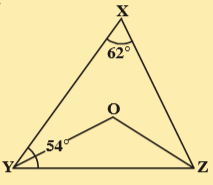
Sol.Given that ∠X = 62°, ∠Y = 54°. YO and ZO are the bisectors of ∠Y and ∠Z in \Delta XYZ
\angle X+\angle XYZ+\angle XZY=180^{\circ}
62^{\circ}+54^{\circ}+\angle XZY=180^{\circ}
\Rightarrow \angle XYZ=180^{\circ}-116^{\circ}=64^{\circ}
Also in \Delta OYZ
\angle OYZ=\frac{1}{2}\angle XYZ=\frac{1}{2}X54^{\circ}=27^{\circ}
(\because YO is bisector of \angle XYZ)
\angle OZY=\frac{1}{2}\angle XZY=\frac{1}{2}X64^{\circ}=32^{\circ}
(\because OZ is bisector of \angle XYZ)
And \angle OYZ+\angle OZY+\angle YOZ=180^{\circ}
(\because angle sum property, \Delta OYZ
\Rightarrow 27+32^{\circ}+\angle YOZ=180^{\circ}
\Rightarrow \angle YOZ=180^{\circ}-59^{\circ}=121^{\circ}
10.In the given figure if AB || DE, ∠BAC = 35° and ∠CDE = 53°, find ∠DCE.
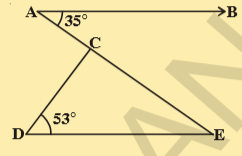
Sol.Given that AB || DE, ∠CDE = 53°;∠BAC = 35°
Now \angle E=35^{\circ}
(\because alternate interior angles)
Now in \Delta CDE
\angle C+\angle D+\angle E=180^{\circ}
(\because ANGLE SUM PROPERTY,\Delta CDE)
\therefore \angle DCE+53^{\circ}+35^{\circ}=180^{\circ}
\Rightarrow \angle DCE=180^{\circ}-88^{\circ}=92^{\circ}
11.In the given figure if line segments PQ and RS intersect at point T, such that ∠PRT = 40°, ∠RPT = 95° and ∠TSQ = 75°, find ∠SQT.
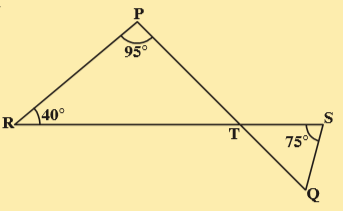
Sol.Given that ∠PRT = 40°, ∠RPT = 95° and ∠TSQ = 75°
In \Delta PRT\angle P+\angle R+\angle PTR=180^{\circ}
(\because angle sum property)
95^{\circ}+40^{\circ}+\angle PTR=180^{\circ}
\Rightarrow \angle PTR=180^{\circ}-135^{\circ}=45^{\circ}
Now \angle PTR=\angle STQ
(\because vertically opposite angles)
In \Delta STQ\angle S+\angle Q+\angle STQ=180^{\circ}
(\because angle sum property)
75^{\circ}+\angle SQT+45^{\circ}=180^{\circ}
\therefore \angle SQT=180^{\circ}-120^{\circ}=60^{\circ}
12.In the adjacent figure, ABC is a triangle in which ∠B = 50° and ∠C = 70°. Sides AB and AC are produced. If ‘z’ is the measure of the angle between the bisectors of the exterior angles so formed, then find ‘z’
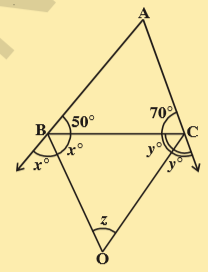
Sol.Given that \angle B = 50^{\circ} ; \angle C=70^{\circ}
Angle between bisectors of exterior angles B and C is Z.
From the figure
50^{\circ}+2x=180^{\circ}
70+2y=180^{\circ}
(\because linear pair of angles)
\therefore 2x=180^{\circ}-50
2x=130^{\circ}
x=\frac{130}{2}
=65^{\circ}
2y=180^{\circ}-70^{\circ}
2y=110^{\circ}
y=\frac{110^{\circ}}{2}
=55^{\circ}
Now in \Delta BOC
x+y+z=180^{\circ} (\because angle sum property)
65^{\circ}+55^{\circ}+z=180^{\circ}
z=180{\circ}-120^{\circ}=60^{\circ}



0 Doubts's